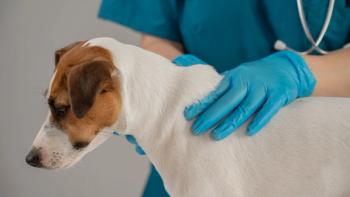
Understanding harmful effects of sun exposure to the skin
In my last article, I discussed skin diseases that result from not enough sun exposure, i.e. seasonal flank alopecia or light responsive alopecia. With the coming of summer, it is timely to offer attention to skin diseases that are exacerbated by sunlight.
In my last article, I discussed skin diseases that result from not enough sun exposure, i.e. seasonal flank alopecia or light responsive alopecia. With the coming of summer, it is timely to offer attention to skin diseases that are exacerbated by sunlight. The most common of these is discoid lupus erythematosus (DLE). Other less common diseases include the remaining diseases that constitute "nasal solar dermatitis"– pemphigus foliaceus, pemphigus erythematosus, systemic lupus erythematosus and actinic dermatitis.
Photo 1: Nasal depigmentation in a Shepherd mix with DLE.
DLE
DLE is essentially a benign skin disease but its clinical appearance can be worrisome to an owner (Photo 1). It is most commonly seen in German Shepherds and Collies but other reported breeds include Doberman Pinschers, Siberian Huskies, Akitas, Shetland Sheepdogs, Brittany Spaniels and German Shorthair Pointers. It is rare in the cat. The most common clinical presentation in the dog is a nasal dermatitis that may include depigmentation, crusting, ulceration and erythema of the nares and a smoothing over of the normal cobblestone appearance of the nasal planum. Other involved areas may include lips, vulva, periocular area, scrotum, pinnae, feet and rarely ulcerations of the tongue and palate. Although DLE is a benign disease (it is unknown if DLE converts to systemic lupus erythematosus in the dog) the differential diagnoses involve more serious diseases such as pemphigus foliaceus, pemphigus erythematosus, dermatophytosis, dermatomyositis, mucocutaneous pyoderma, epitheliotropic lymphoma and uveodermatologic syndrome (VKH-like disease) (Photo 2). Recently a hereditary-nasal hyperkeratosis of Labrador Retrievers has been described as well as a disease of St. Bernards and Giant Schnauzers, which results in arterial bleeding episodes.
Photo 2: Siberian Husky with dermatophytosis.
Laboratory parameters such as complete blood counts, serum chemistries, urinalyses and ANA titers are negative or normal. Skin biopsies are the method of definitive diagnosis. Biopsy results may include an interface dermatitis composed of mononuclear cells and plasma cells, hydropic degeneration of basal cells, pigmentary incontinence and focal thickening of the basal cell membrane. Immunohistochemistry may be helpful as an adjunct to H&E biopsies, but regular skin biopsies submitted in 10 percent formalin for H&E staining provide the most reliable results.
Treatment options
Therapies range from topicals to systemic medications but should always include sun avoidance. Sunscreen of at least SPF 15 or higher may be used once the disease is in remission. Sunscreen should be used with caution on ulcerated skin because of possible contact sensitivity reactions. For initial treatment of DLE, we usually start with topical therapy and oral vitamin E then move onto systemic medications in a stepwise fashion if the topicals are not successful. Topical steroids such as fluocinonide ointment 0.1 percent or Synotic (fluocinonide with DMSO) are applied once or twice daily. We usually have the owner apply the ointment, then feed the dog treats or have him/her hold a toy for three to five minutes to allow the ointment to penetrate the skin. If the pet experiences polyuria or polydipsia on the topical steroid (seems to happen most in Huskies), then a lower concentration of steroid ointment such as hydrocortisone 1 percent is used. Steroid ointments are used initially daily, then on an as-needed basis. Oral vitamin E at doses of 400-1000 iu orally SID accompany the topical steroids. Some owners report topical vitamin E has been helpful, but in humans, topical vitamin E can be a contact sensitizer. A nonsteroidal topical immunomodulator, tacrolimus (Protopic .1 percent), has been helpful in DLE. It is used in humans for eczema and appears to be safe for use even in children. It is applied twice daily in dogs but can be expensive (about $70/tube). Anecdotal reports of 1 percent cyclosporine in oil applied topically twice daily have had varied success.
Photo 3: Nasal ulceration, depigmentation and crusting in a Collie with DLE.
An occasional patient with DLE will respond to antibiotics alone. We had a young Collie that responded to Lincocin 10 mg/lb bid (Photos 3 and 4). Fatty acids such as omega 3, 6 found in products such as DermCaps and EFA Caps have also been helpful. When none of the above "innocuous" therapies has been helpful, our next step is to add the combination of tetracycline and niacinamide. In patients <10 kg, 250 mg of each TID is administered, for patients> 10 kg, 500 mg TID of each is given. This combination has been used in humans for DLE and can be successful in up to 75 percent of canine patients with DLE. The mechanism of action is uncertain but the combination of the antibiotic and the B vitamin can inhibit the inflammatory cells from accumulating in certain areas of the skin. It is important to use niacinamide and not niacin, because niacin can be hepatotoxic in dogs. Doxycycline at 5 mg/kg BID has been used by some dermatologists in place of tetracycline. This drug combination can take up to 60 days to become effective.
Photo 4: Progression of DLE in the Collie in Photo 3 that was not kept out of the sun.
In cases that are nonresponsive to topicals or the vitamin E/fatty acids/tetracycline and niacinamide combinations, prednisone at 1 mg/lb QOD can be used to get the patient into remission. Often, once the patient is into remission with oral steroids, topicals can take over to keep it under control. The worst-case scenario is a patient that requires oral steroids to stay in remission. In that case, oral azathioprine at 1 mg/lb QOD is added after first checking a complete blood count, then repeating blood counts two to three weeks later, then again three weeks later, and again three weeks later. Azathioprine can cause a reduced white blood cell count, red blood cell count or reduced platelet count so CBC's are performed to carefully watch for any reductions. If the addition of azathioprine puts the patient into remission, then the steroid dose is slowly reduced over a period of weeks to hopefully wean them off and have them under control with azathioprine only. If long-term azathioprine is needed, routine CBC's and yearly serum profiles should be monitored as pancreatitis and hepatitis have been reported with azathioprine as well as anecdotal reports of sudden death.
As a bit of "local" information, The Skin Study Center of the University Hospitals of Cleveland/Case Western Reserve University led by director, Elma Baron, MD, have researched white tea and its protective effects against UV-induced immune suppression. It also has protective anticancer effects and possible antiphotoaging effects. The product is commercially available at the Origins cosmetics counter. It is unknown whether or not this would be helpful in dogs, because the research was done on light-skinned humans, but it may be an alternative to steroids particularly in early cases of sun exposure.
Newsletter
From exam room tips to practice management insights, get trusted veterinary news delivered straight to your inbox—subscribe to dvm360.





